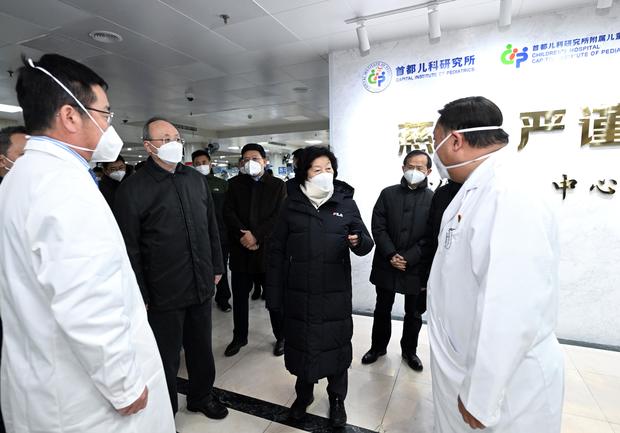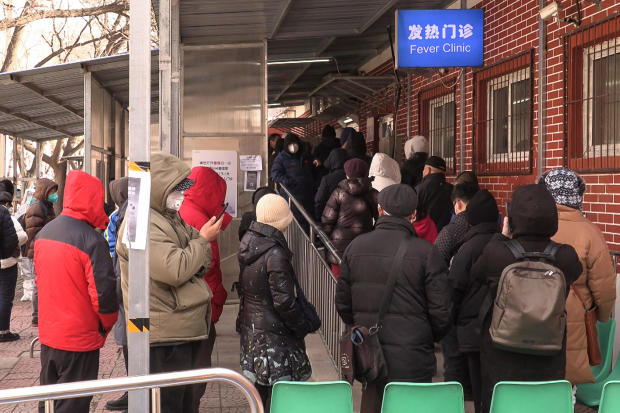China accepts “no way to keep track” of COVID cases amid shift from eradication strategy to “treatment”
[ad_1]
Beijing — A week after China’s health authorities sparked chaos and confusion by announcing sweeping changes to the country’s draconian COVID-19 control measures, the government’s coronavirus czar has tried to bring some clarity about the new strategy. In doing so, China’s government has admitted for the first time that it’s impossible to try and detect and track every case of the coronavirus.
Many across China, but particularly in the immense capital city of Beijing, have been desperate for more information given an anecdotal rise in sickness that doesn’t seem to match up with official case counts, which have suggested a drop in the spread of the virus.
As of one week ago China has been allowing people infected with COVID-19 to quarantine at home with asymptomatic or mild cases, and it has dropped the requirement for everyone to show a recent negative test result before entering most public places.
Dake Kang/AP
The abrupt U-turn in the country’s strict “zero-COVID” policy came after rare public protests against the measures, but what replaced the long-standing rules — and the stern rhetoric about the dangers of catching COVID-19 — was a lack of clear guidance that led to a rush on everything from cold and flu medicines to at-home test kits.
Visiting hospitals on Tuesday, China’s top official on the coronavirus, Vice Premier Sun Chunlan, explained that the country’s focus should shift from “preventing infections” to “medical treatment” of those suffering with the virus. The very clear goal of the last three years, in other words, of quickly isolating and stamping out any infections at all, has been changed to preventing and treating severe cases.
Yan Yan/Xinhua/Getty
As part of the new strategy, which broadly reflects the policies adopted many months ago by many other major economies, China’s National Health Commission announced Wednesday that it would no longer report the number of asymptomatic cases in the country. With the mandatory mass-testing that had impeded everyday life for years now officially abandoned, the commission said there was “no way to keep track of actual numbers” of infections.
The announcement was added without fanfare as a note on the health service’s daily report of COVID cases — and the recent downward trend reflected in that report may be largely explained by the sudden, massive drop in testing. Official caseloads have been declining steadily since late November, but anecdotal evidence from Chinese social media suggests many people are still catching the virus.
For days, “fever clinics” around the Chinese capital have had lines of people waiting outside in the cold for COVID tests or treatment for hours. Common cold, flu and pain medicines and the rapid at-home antigen test kits are in extremely short supply. Demand for the tests has soared as many of the government-run PCR test booths that became regular fixtures across Chinese cities during the last few years have been dismantled over the last couple weeks.
YUXUAN ZHANG/AFPTV/AFP/Getty
On Saturday, Beijing’s emergency services received six times as many calls as usual. On Sunday, the number of people visiting the capital’s fever clinics spiked to 16 times the usual level.
The general public have not been alone in struggling to adjust to the new strategy. The National Bureau of Statistics cancelled its regularly scheduled monthly news conference this week, saying it would instead release COVID case data online. Taiwanese media pointed out that Beijing’s office in charge of relations with the democratically governed island had canceled two consecutive media briefings.
One of the biggest problems for China as it eased its tight anti-virus rules was the relatively low proportion of the country’s vast, 1.4 billion-strong population who have been fully vaccinated and boosted against COVID-19. Chinese authorities declined for years to use Western-developed vaccines, sticking with the country’s domestic products which didn’t perform as well during clinical trials.
Of particular concern, many older Chinese citizens remain un- or under-vaccinated, though the government did announce a major vaccination push when it dropped the zero-COVID policy last week.
There was a new glimmer of hope this week, however, as a domestic healthcare app started selling Pfizer’s COVID-19 treatment PAXLOVID to anyone with a positive test result. Even at $426.80 per box, the medicine reportedly sold out on the app within half an hour.
CBS News’ Tucker Reals contributed to this report.
[ad_2]
Source link













